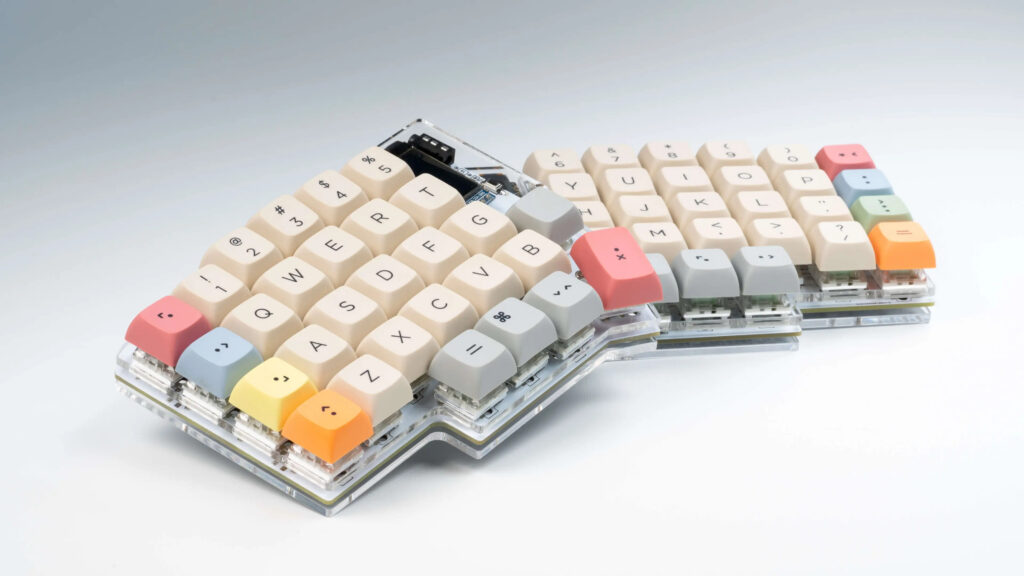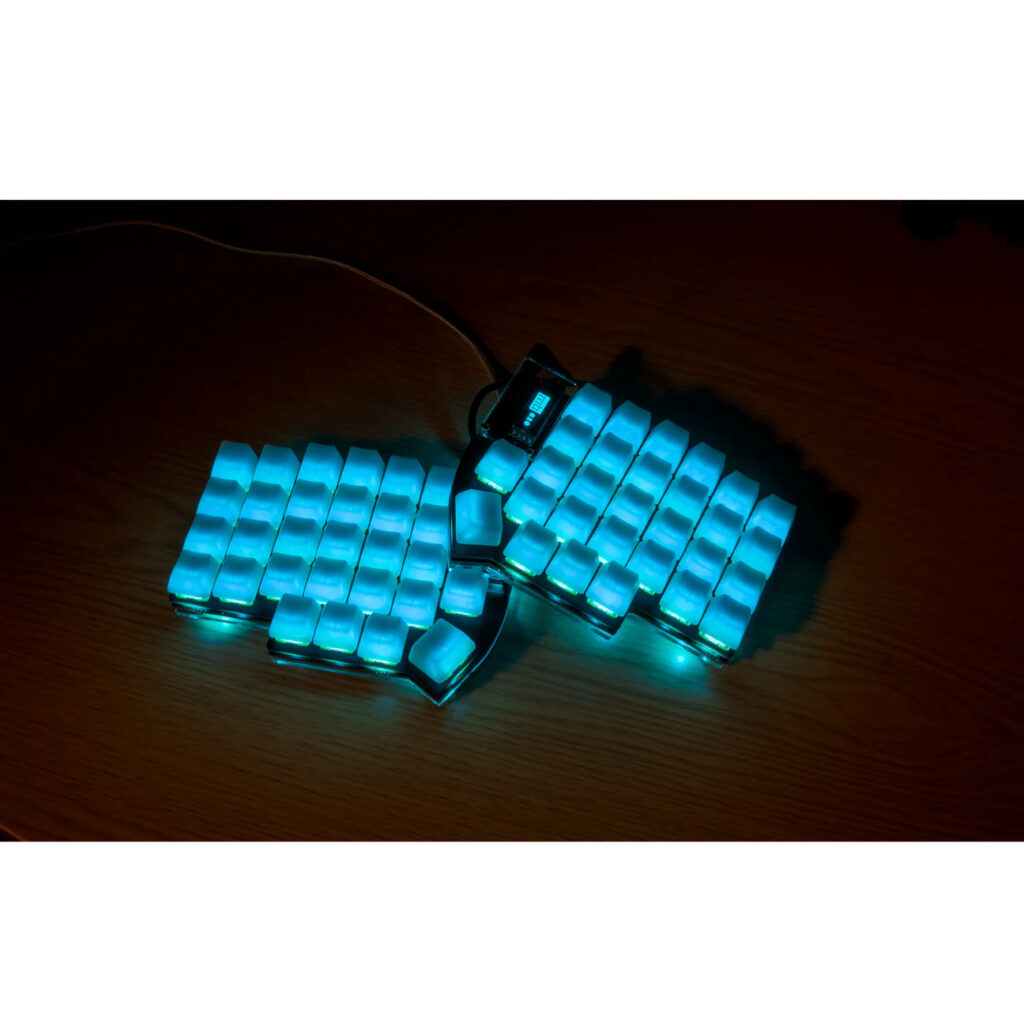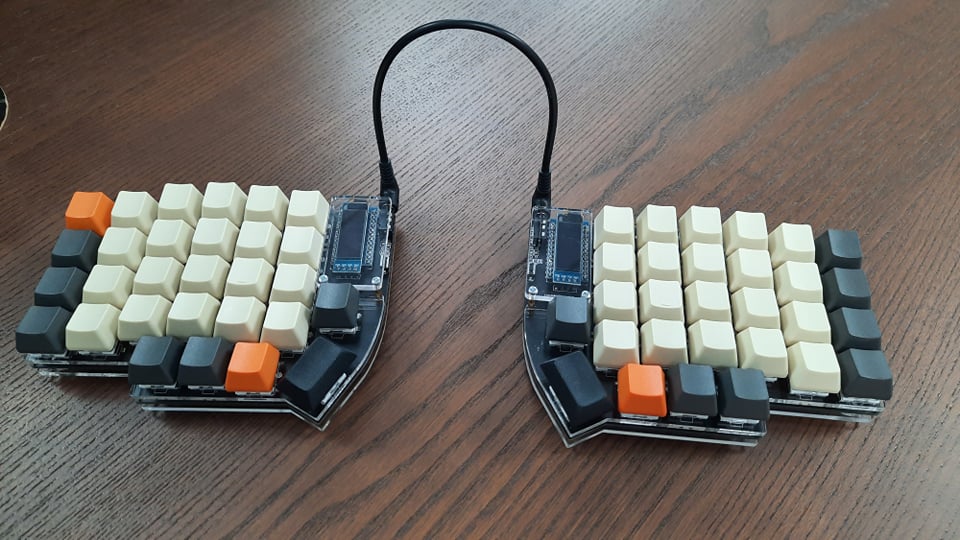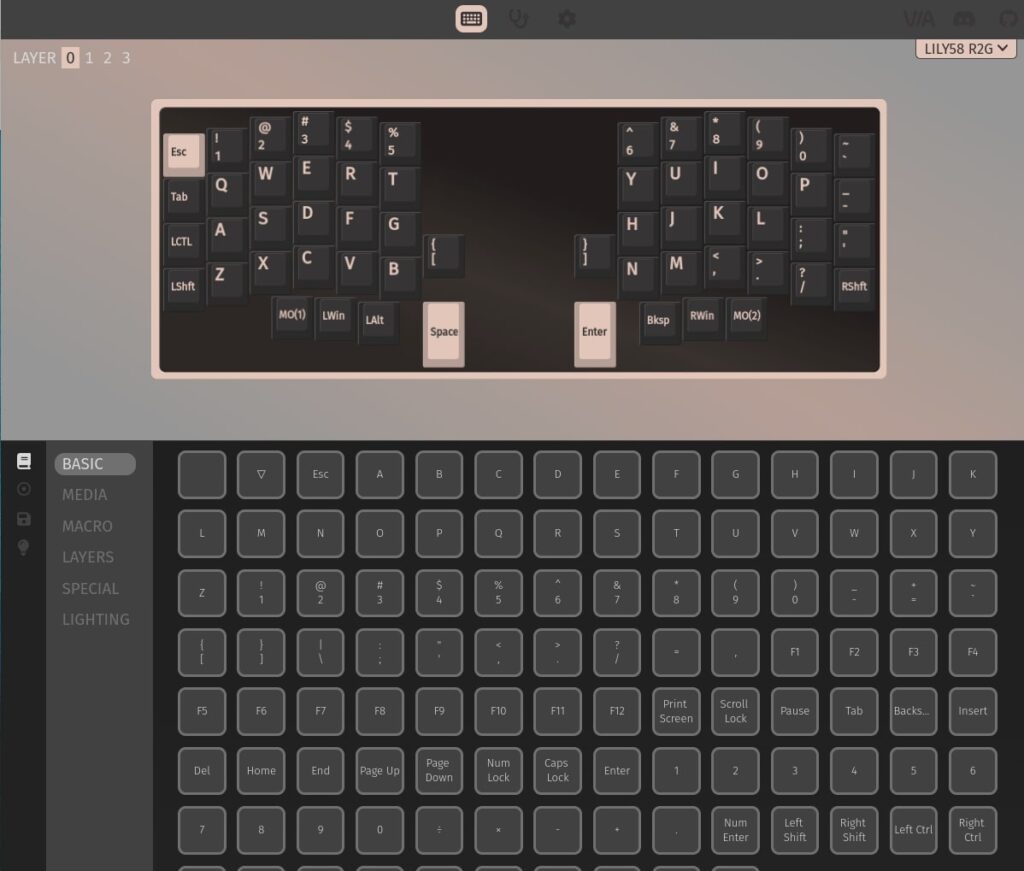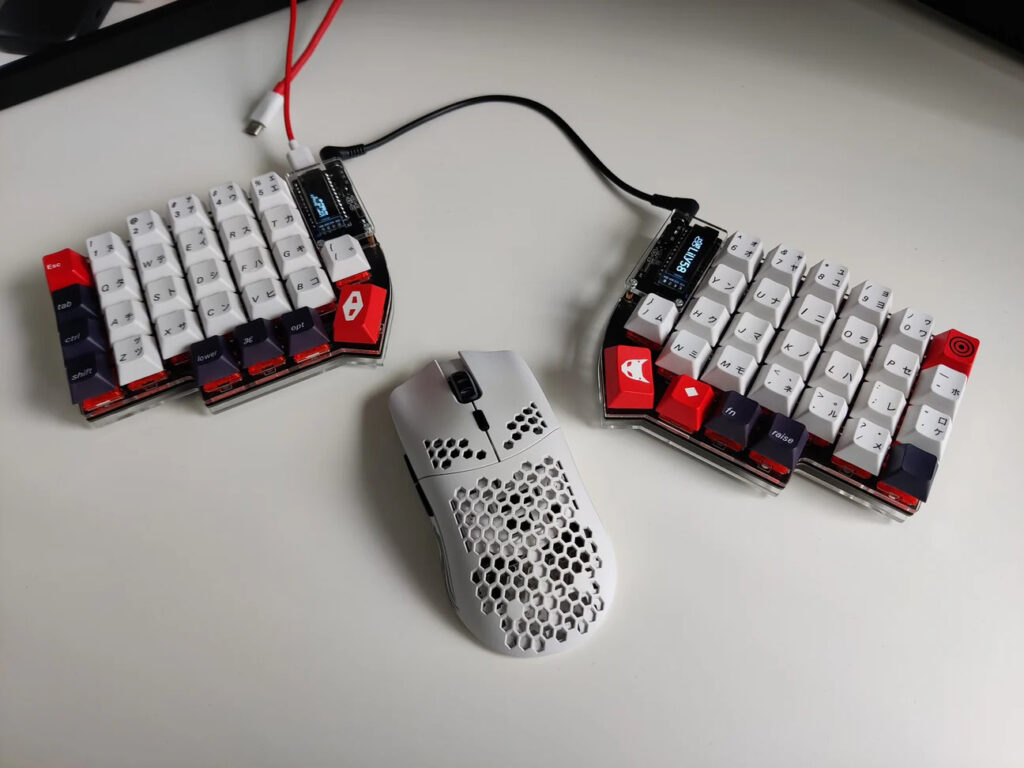The Lily58 keyboard has emerged as a cult favorite in the mechanical keyboard community, striking a balance between ergonomic design and DIY customization. With its 58-key split layout, open-source PCB, and support for both MX and Kailh Choc switches, it caters to users seeking relief from traditional staggered keyboards while retaining enough keys to avoid excessive layer reliance. This review dissects its build quality, firmware flexibility, and ecosystem, drawing from hands-on testing and community feedback to help you decide if it’s the right split keyboard for your workflow.
Technical Specifications and Design Philosophy
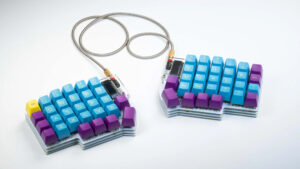



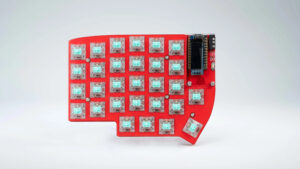

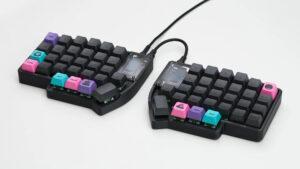
Core Architecture
The Lily58 is a 6×4 column-staggered split keyboard with a 4-key thumb cluster per side, totalling 58 keys. Its PCB supports:
MX and Choc switches on the same board (via hot-swap sockets or soldering)
QMK/VIA and ZMK firmware for wireless builds (e.g., with Nice!Nano controllers)
OLED displays (128×32 pixels) for layer indicators or custom graphics
Underglow RGB via SK6812 mini-E LEDs (hardwired)
Rotary encoder support on select variants (requires PCB modification)
Key Layout Analysis
Compared to boards such as the Planck, the slight columnar stagger is less elongating on the fingers.
The pinky columns do not have the same extreme staggering found in the Kyria or Corne, which some users find off-putting for small hands. As to the thumb cluster, it groups four keys within 1U of the home position, which is an improvement compared to the Ergodox’s sprawling placement.
Build Experience: Kits vs. Pre-Built Options
DIY Kits (KeyHive, Boardsource, Mechboards)
| Vendor | Hot-Swap Support | Controllers Included | Case Options | Price Range |
|---|---|---|---|---|
| KeyHive | MX/Choc | No | FR4 plates | $50–$80 |
| Boardsource | MX/Choc | Pro Micro/Nice!Nano | 3D-printed/acrylic | $120–$200 |
| Mechboards | Choc-only | Pre-soldered | Carbon fiber/acrylic | $150–$250 |
Soldering Complexity:
Through-hole kits require diode soldering but offer cost savings.
Hot-swap kits use Kailh sockets, reducing assembly time but increasing upfront cost.
Wireless mods demand precise soldering for Li-Po battery connectors and Nice! Nano controllers18.
A user on r/ErgoMechKeyboards noted: “The Lily58’s PCB is beginner-friendly, but the RGB underglow requires careful handwiring. I’d recommend skipping LEDs for first-time builders”
Firmware and Customization
QMK/VIA vs. ZMK
| Feature | QMK/VIA (Wired) | ZMK (Wireless) |
|---|---|---|
| Layer Switching | Instant | 5ms delay |
| RGB Control | Full spectrum | Limited to underglow |
| Encoder Support | Native | Requires custom code |
| Battery Life | N/A | 2–3 weeks (110mAh) |
VIA Configuration Example:
// Lily58 keymap.c snippet for a gaming layer
#ifdef SWAP_HANDS_ENABLE
__attribute__ ((weak))
const keypos_t PROGMEM hand_swap_config[MATRIX_ROWS][MATRIX_COLS] = {
{{0, 5}, {1, 5}, {2, 5}, {3, 5}},
{{0, 6}, {1, 6}, {2, 6}, {3, 6}}
};
#endif
This enables hand swapping for left/right gaming modes
Ergonomics: Lily58 vs. Iris vs. Sofle
Thumb Cluster Comparison
| Model | Thumb Keys | Reachability (1U=19mm) | Open-Source |
|---|---|---|---|
| Lily58 | 4 per side | 1U–1.5U | Yes |
| Iris | 3–4 | 1.5U–2U | No |
| Sofle | 5 per side | 1U–1.25U | Yes |
A Reddit user highlighted: “The Iris’s thumb keys are too far for my small hands. Lily58’s cluster feels natural, but Sofle’s added encoder and keys won me over”
Layout Efficiency
Lily58: 58 keys minimize layer toggling for programming (vs. 34 keys on a Corne).
Sofle V2: Adds two extra keys and encoder support but increases the pinky stretch.
Iris Rev7: Lacks hot-swap sockets and uses soldered controllers, limiting mods.
User Experience and Modding Potential
Case Options
High-profile acrylic: Supports MX switches only, adds 20mm height.
3D-printed tented: Allows 15°–30° tilting (requires M2 spacers).
Carbon fibre: Premium option at Mechboards, reduces flex during heavy typing.
Mod Spotlight: Adding Encoders
While the Lily58 lacks native encoder footprints, a community guide shows how to:
Solder EC11 encoders to unused OLED pins (D4, C6).
Modify the PCB matrix in QMK’s
config.h.3D-print a custom top plate for encoder clearance
Critiques and Workarounds
Common Complaints
Limited Stagger: Pinky columns don’t drop enough for users with small hands.
Fix: Use Choc switches (3.8mm travel) or sculpted keycaps like MBK.
No Wireless Out-of-Box: Requires $40+ Nice!Nano controllers.
Keycap Rarity: 1.5U thumb keys aren’t included in most sets.
Fix: MBK Legend from Mechboards or 3D-printed DSA caps.
A Hashbangcode user lamented: “Finding ortholinear keycaps in the UK was a nightmare. I settled for mismatched DSA profiles”
Frequently Asked Questions (FAQ)
Q1: Does the Lily58 require soldering?
The Lily58 is available in DIY kits (requiring soldering for diodes, controllers, and LEDs) and pre-soldered “Ready-to-Go” (R2G) variants. Wireless builds demand soldering Nice! Nano controllers and battery connectors, while hot-swap kits eliminate switch soldering.
Q2: How long does the battery last on a wireless Lily58 build?
With 110mAh Li-Po batteries and Nice!Nano controllers, the wireless Lily58 lasts 2–3 weeks under moderate use. The left half drains faster (~1 week) due to primary Bluetooth responsibilities, while the right half lasts longer.
Q3: Are Lily58 keycaps compatible with standard MX sets?
The Lily58 requires 1.5U thumb keys and uniform-profile keycaps (e.g., DSA, XDA) for its ortholinear layout. Most Cherry-profile sets cause uneven heights on staggered columns. MBK Legend Choc keycaps or 3D-printed DSA caps are recommended.
Q4: Why isn’t my Lily58 recognized by QMK/VIA?
Ensure TRRS and USB-C cables are fully inserted and use a data-capable USB cable. For VIA compatibility, flash via_enable = yes in rules.mk and reprogram both halves separately.
Q5: Can I add rotary encoders to the Lily58?
While the Lily58 lacks native encoder footprints, community mods allow soldering EC11 encoders to unused OLED pins (D4/C6). This requires custom top plates and QMK matrix adjustments.
Q6: How does the Lily58 compare to the Iris for small hands?
The Lily58’s 1U–1.5U thumb reach suits smaller hands better than the Iris’s 1.5U–2U stretch. However, its pinky columns lack Kyria’s aggressive stagger, which some users find limiting.
Q7: Is the Lily58 compatible with ZMK firmware?
Yes, using Nice!Nano controllers, though ZMK lacks QMK’s RGB underglow control and has a 5ms layer-switch delay. Wireless builds require ZMK, while wired setups favor QMK/VIA.
Q8: What’s the difference between MX and Choc variants?
MX variants support taller switches (e.g., Gateron) and standard keycaps, while Choc variants use low-profile switches (3.8mm travel) and require compact 18×17mm spacing. Cases are incompatible between versions.
Conclusion: Who Should Buy the Lily58?
Ideal For:
Ergo Newbies: 58 keys ease the transition from 60% boards.
QMK Tinkerers: Open-source firmware invites deep customization.
Hybrid Typists: MX/Choc support accommodates gaming and typing.
Avoid If:
You want out-of-the-box wireless (consider Sofle RGB).
Your hands are smaller than 17cm (pinky reach may strain).
Final Verdict
The Lily58 remains a top contender in the split keyboard arena, offering just enough keys to avoid layer fatigue while encouraging DIY experimentation. Its thriving ecosystem of cases, controllers, and firmware tweaks makes it a canvas for ergonomic expression—flaws and all.
Our journey into the world of mechanical keyboards doesn’t end with the Lily58’s split ergonomic design. As we’ve discovered while testing this DIY marvel, the quest for the perfect typing experience often leads down fascinating paths—much like our exploration of the Wooting 60HE V2 or the Bridge75 for those preferring a more traditional layout but equal customization. For Lily58 builders confused about keycap choices, our ABS vs PBT Keycaps comparison provides clarity, while those seeking comfort during long coding sessions might appreciate our guide to wrist rests that work perfectly with low-profile split keyboards. Whether you’re a mechanical keyboard enthusiast or just beginning your ergonomic journey, the Lily58 represents just one fascinating stop in the wider landscape of personalized computing that we’re passionate about exploring.
